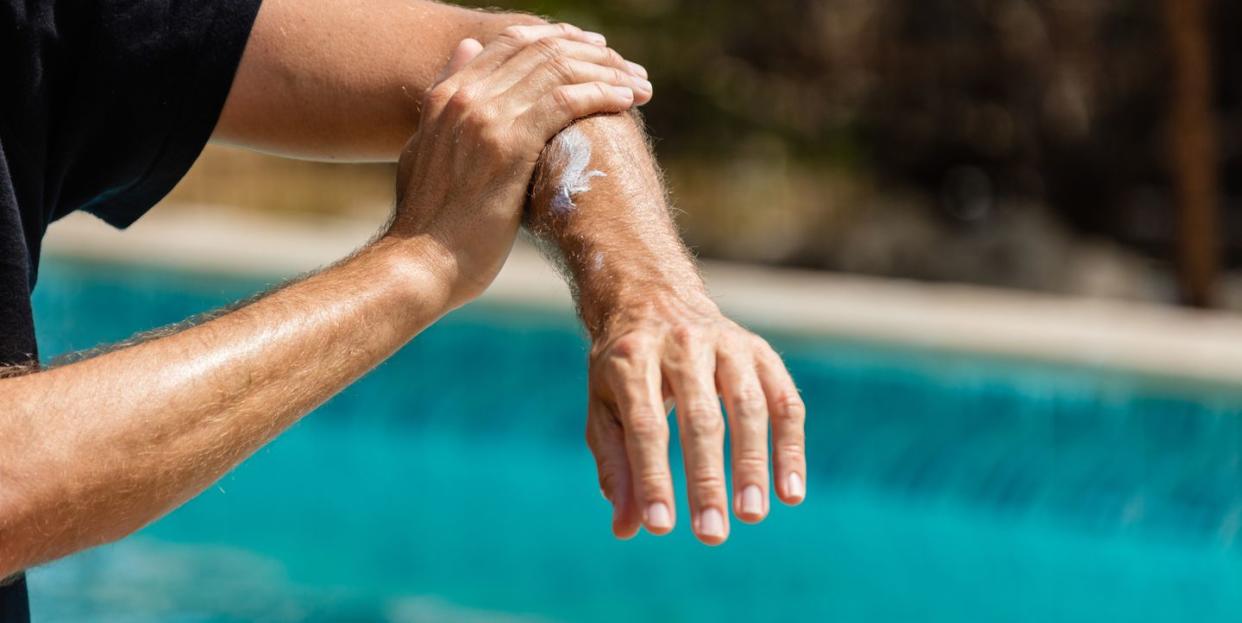PSA: Homemade Sunscreen Is a Really Terrible Idea

After researchers analyzed the ingredients in 189 posts on Pinterest for homemade or natural sunscreens, they found the vast majority of recipes offered inadequate sun protection.
In the study published in Health Communication, only 35 percent of pins for homemade sunscreen contained zinc oxide, an ingredient that makes sunscreens effective.
Many recipes were made with essential oils and other household ingredients that contain less than 15 SPF.
Slathering on some sunscreen before heading out for a ride or off to the beach is the best way to protect yourself from the sun’s harmful rays and guard against sunburn and skin cancer. But, as people are looking for more ways to lessen their environmental impact, it turns out people are searching Pinterest for homemade alternatives to sunscreen.
If that doesn’t sound like the safest solution to you, well, you’re right: Homemade sunscreens are not effective at protecting against the sun’s harmful rays, according to a study published in Health Communication
In the study, researchers randomly sampled pins using the search terms “homemade sunscreen” and “natural sunscreen” to come up with the 189 they analyzed for their research. They found that 95 percent of them positively portrayed the effectiveness of homemade sunscreen. Any pins that mentioned SPF boasted effectiveness ranging from 2 to 50, though they had nothing to actually back those claims up.
And 65 percent of the pins ended up recommending recipes that offered inadequate UV protection, which can leave you vulnerable to sunburn and raise your risk of skin cancer down the line.
These recipes were inadequate because the ingredients used to make them-like coconut oil, lavender oil, shea butter, and bees wax-all provide less than 15 SPF.
In fact, only 35 percent of the recipes included zinc oxide, a sunscreen ingredient you can find in commercial products that has been proven effective.
But even that wasn’t enough to guarantee safe protection, since it is not known if users following these recipes included sufficient amounts of zinc oxide and thoroughly incorporated the ingredient through the mixture-both key for effective SPF, explained study author Julie Williams Merten, Ph.D., an associate professor of public health at the University of North Florida.
“There are great commercially available sunscreens that are regulated and tested for efficacy and safety,” Merten said. “Homemade sunscreens haven’t been tested for their true UV protection, water resistance or photostability, which places people at risk for sunburn and even worse-skin cancer.”
[Find 52 weeks of tips and motivation, with space to fill in your mileage and favorite routes, with the Bicycling Training Journal.]
Sunscreens are readily available, and pretty inexpensive, so why would people turn to homemade stuff anyway? That may come down to the shift in concern for environmental harm that is thought to be caused to the coral reef by ingredients like oxybenzone in certain sunscreens.
There are legitimate concerns about coral reef destruction and endocrine disruption-which can affect the body’s production of hormones-according to Merten. But in most cases, sunscreen is just one piece of the puzzle.
“It is important that we don’t send a message that we should stop using commercial sunscreen-or start making our own concoctions,” she said.
If you are worried about the environmental impact, Merten suggests sunscreens considered mineral blockers, such as those that are zinc oxide or titanium dioxide based (which the FDA considers safe and effective), rather than the chemical sunscreens that receive the brunt of the criticism. The mineral blockers sit on top of the skin and work to reflect the suns rays, while chemical sunscreens absorb UV radiation before it harms the skin.
Keep in mind, the American Academy of Dermatology (AAD) recommends most adults need 1 ounce of SPF 30 or higher-enough to fill a shot glass-to fully cover their body.
The AAD also recommends applying sunscreen 15 minutes before going outdoors and reapplying every two hours and after sweating based on the recommendations on the bottle. So, if you’re out for a long ride, or a day at the beach, make sure you’re applying-and reapplying-sunscreen that you bought at the store.
('You Might Also Like',)

